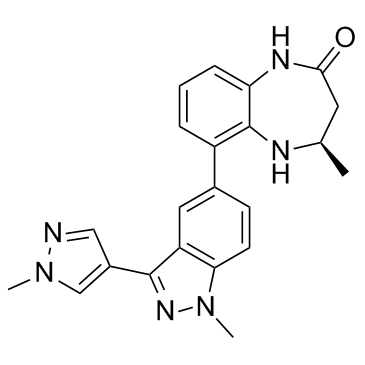
CPI-637
CAS No. 1884712-47-3
CPI-637 ( CPI637;CPI 637 )
Catalog No. M12946 CAS No. 1884712-47-3
A potent and selective, cell-active CBP/EP300 bromodomain inhibitor with CBP BRET EC50 of 0.03 uM.
Purity : >98% (HPLC)
 COA
COA
 Datasheet
Datasheet
 HNMR
HNMR
 HPLC
HPLC
 MSDS
MSDS
 Handing Instructions
Handing Instructions
| Size | Price / USD | Stock | Quantity |
| 2MG | 42 | In Stock |


|
| 5MG | 64 | In Stock |


|
| 10MG | 92 | In Stock |


|
| 25MG | 201 | In Stock |


|
| 50MG | 357 | In Stock |


|
| 100MG | 537 | In Stock |


|
| 500MG | 1134 | In Stock |


|
| 1G | Get Quote | In Stock |


|
Biological Information
-
Product NameCPI-637
-
NoteResearch use only, not for human use.
-
Brief DescriptionA potent and selective, cell-active CBP/EP300 bromodomain inhibitor with CBP BRET EC50 of 0.03 uM.
-
DescriptionA potent and selective, cell-active CBP/EP300 bromodomain inhibitor with CBP BRET EC50 of 0.03 uM; displays >700-fold selectivity over the BET bromodomains (BRD4 IC50=11.0 uM), also highly selective against other bromodomains; inhibits the expression of MYC with an EC50 of 0.60 uM in a cellular assay.
-
SynonymsCPI637;CPI 637
-
PathwayChromatin/Epigenetic
-
TargetBromodomain
-
RecptorBRD4;CBP;EP300
-
Research AreaCancer
-
Indication——
Chemical Information
-
CAS Number1884712-47-3
-
Formula Weight386.45
-
Molecular FormulaC22H22N6O
-
Purity>98% (HPLC)
-
SolubilityDMSO
-
SMILESCN(N=C1C2=CN(C)N=C2)C3=C1C=C(C4=CC=CC(N5)=C4N[C@H](C)CC5=O)C=C3
-
Chemical Name2H-1,5-Benzodiazepin-2-one, 1,3,4,5-tetrahydro-4-methyl-6-[1-methyl-3-(1-methyl-1H-pyrazol-4-yl)-1H-indazol-5-yl]-, (4R)-
Shipping & Storage Information
-
Storage(-20℃)
-
ShippingWith Ice Pack
-
Stability≥ 2 years
Reference
1. Taylor AM, et al. ACS Med Chem Lett. 2016 Mar 15;7(5):531-6.
molnova catalog





 Cart
Cart
 sales@molnova.com
sales@molnova.com


